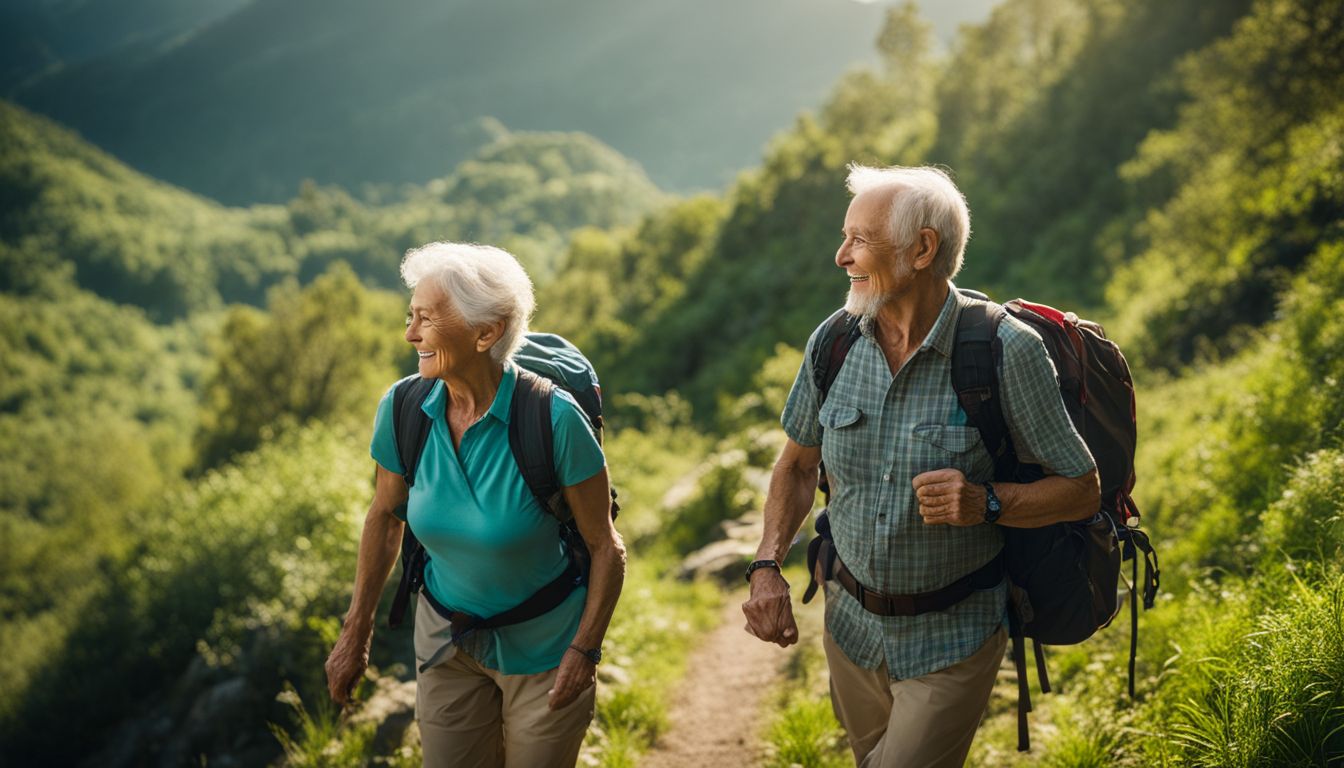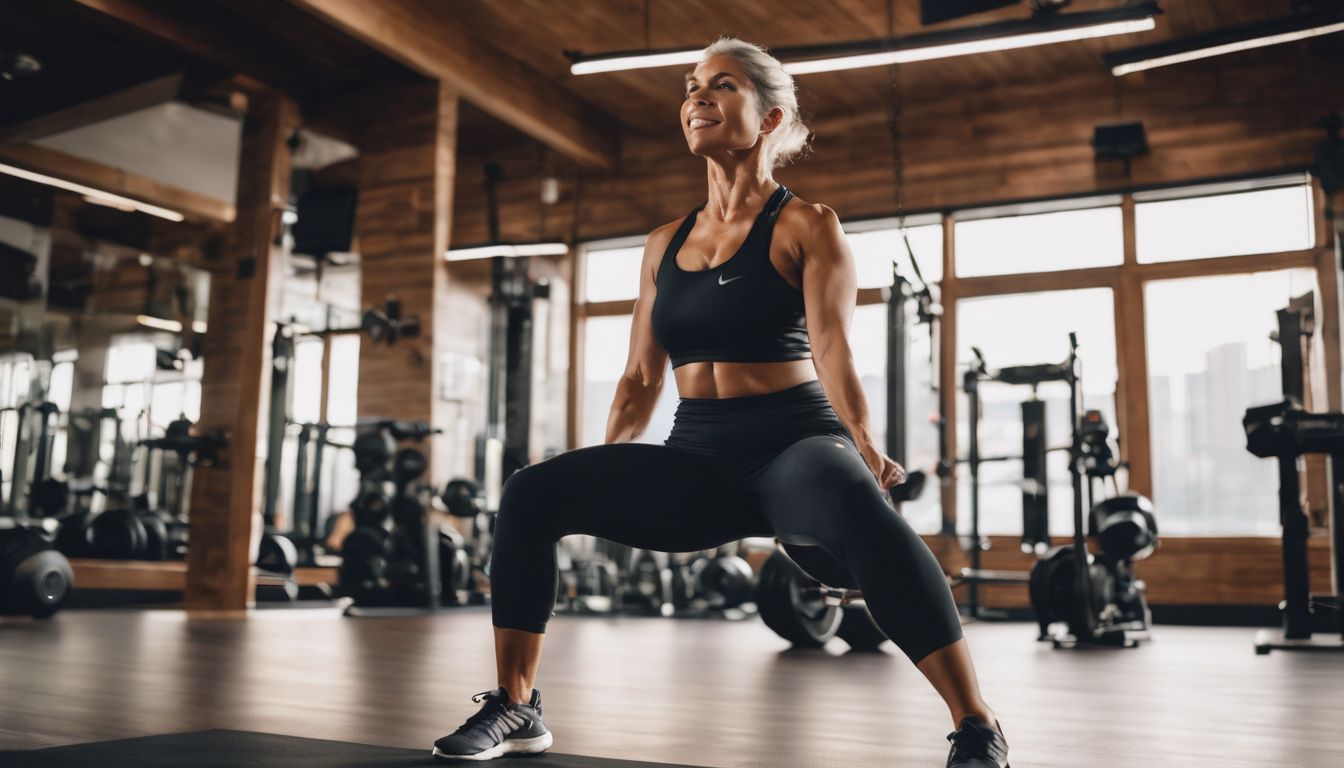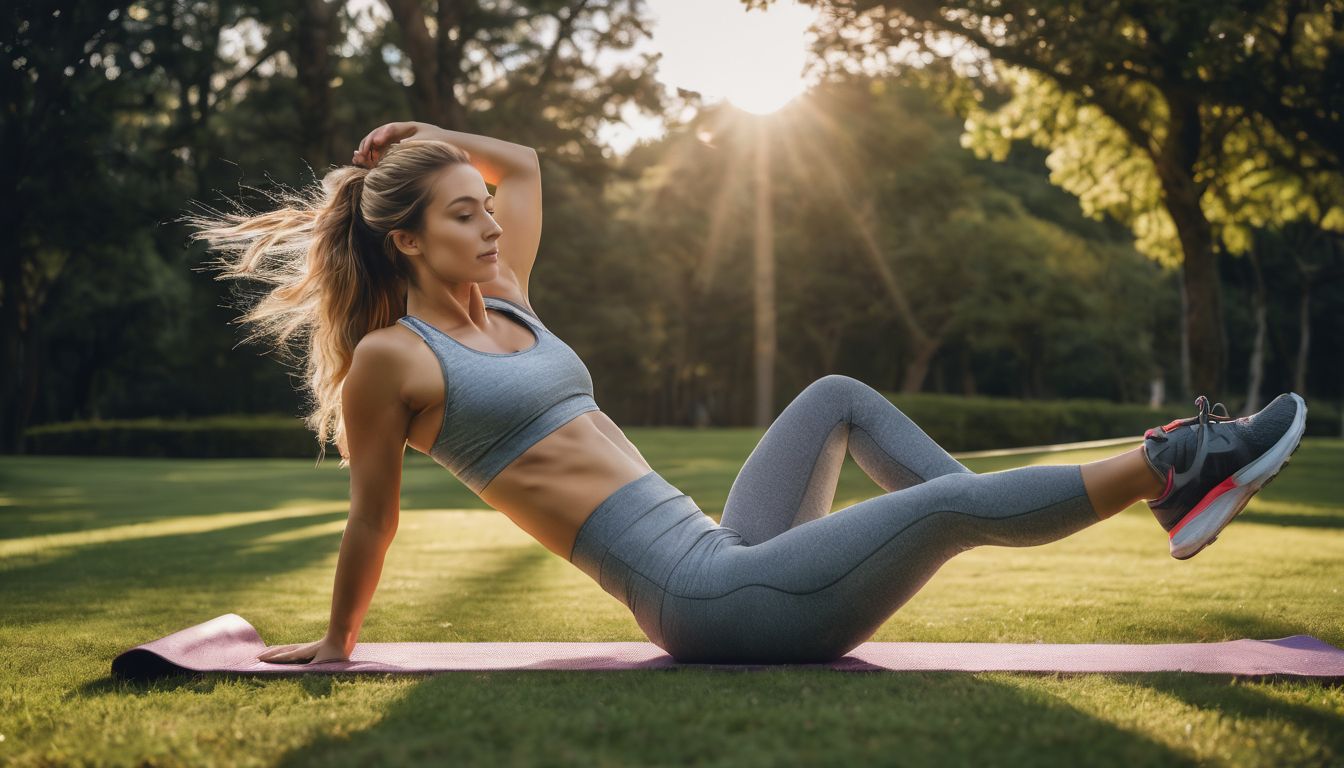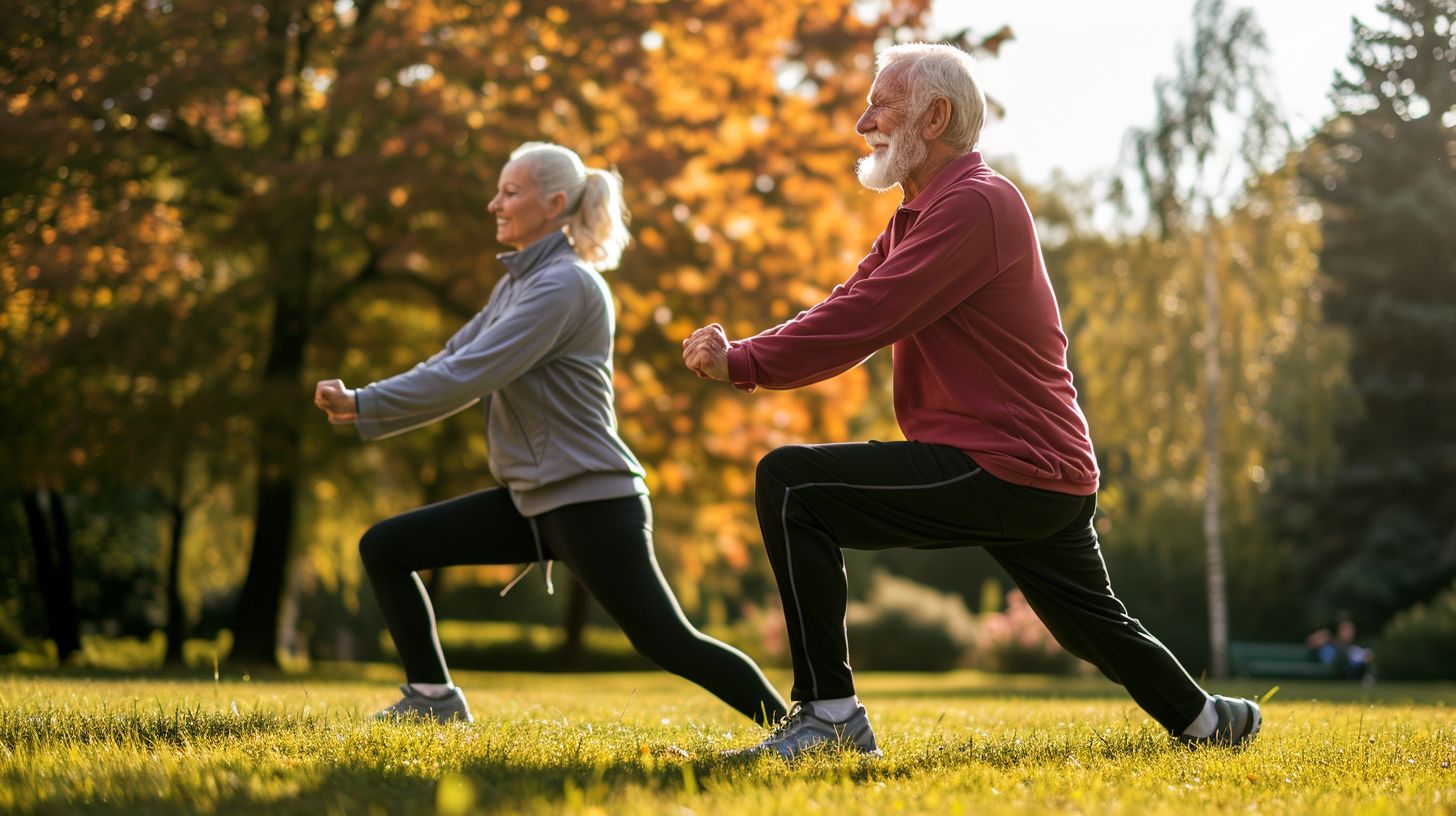As we age, keeping our legs strong is key to staying steady on our feet. Many seniors experience a dip in muscle strength, which can impact everyday tasks and mobility. Luckily, this article offers simple leg-strengthening exercises that improve balance and enhance your daily life.
Dive in for stronger steps ahead!
Key Takeaways
- Strong legs help seniors stay safe, prevent falls, and maintain independence.
- Key exercises like squats, hip marches, and knee extensions keep leg muscles sturdy.
- Seniors should start with simple exercises and slowly increase the intensity to build strength safely.
- It’s important for seniors to eat a healthy diet rich in vitamins and minerals for muscle health.
- Regular leg-strengthening exercises improve balance, stability, and daily life activities for seniors.
Understanding the Importance of Leg Strength for Seniors

Strong legs help seniors stay independent. They make daily tasks easier, like climbing stairs or getting out of a chair. Good leg strength also helps prevent falls, which are a big risk for older adults.
Steady legs mean better balance and more confidence moving around.
Exercises that build muscle in the thighs, calves, and glutes are important as we get older. They keep our legs strong so we can walk and do other activities safely. Working on leg muscles is not just about power; it’s about keeping the ability to live life fully without worry or limitation.
Reasons for Leg Weakness in Seniors

Leg strength isn’t just a matter of mobility for seniors; it’s the cornerstone of independence. Yet, many experience an unwelcome decline in this crucial area due to a mix of medical conditions and lifestyle factors.
This loss can sneak up quietly, but understanding its roots is the first step toward reclaiming stability and balance. Now, let’s dive into what might be sapping leg strength and how targeted exercises can turn the tide.
Peripheral Artery Disease
Peripheral Artery Disease, or PAD, makes your legs weak. It happens when blood vessels in your legs get narrow or blocked. Your muscles don’t get enough blood and can start to hurt or feel heavy.
Walking becomes hard, and you might limp a bit.
Exercise helps fight against PAD’s effects on your legs. It keeps the blood moving and strengthens your leg muscles. Start with gentle activities, like walking short distances, then slowly build up as you grow stronger.
Always check with your doctor before you begin any new exercise if you have PAD. They’ll tell you what’s safe for you to do!
Nutritional Deficiency
Leg weakness isn’t just about blood flow problems like peripheral artery disease. Another big reason for muscle struggles is not getting the right nutrients. Your legs need vitamins and minerals to work well.
Think of them as fuel for your muscles. Without enough Vitamin K, C, D, and B6, or minerals like potassium and calcium, your leg muscles might get weak.
Eating a healthy diet matters a lot for keeping leg strength as you age. Foods rich in essential micronutrients help prevent cramps and muscle loss. If you’re missing out on these key vitamins and minerals, your legs won’t have the power they need for everything from walking to climbing stairs.
It’s important to keep an eye on what you eat to make sure your body gets all it needs to stay strong.
Alzheimer’s and Parkinson’s
Alzheimer’s and Parkinson’s diseases can make legs weak in older folks. These conditions affect the brain and nerves, leading to muscle problems.
Legs might not listen as well and could shake or freeze up. This makes walking tough and raises the chance of falls. Keeping your legs strong helps a lot with balance. Next, let’s talk about some exercises that can keep your legs fit and sturdy.
Diabetes
Diabetes makes the legs weaker and increases the chance of falls. But don’t worry! You can fight back with leg-strengthening exercises that boost your stability and balance. Squats, hip marches, and knee extensions are great places to start.
These moves help keep your muscles strong so you can move better and stay safe.
Regular exercise also helps control blood sugar levels in seniors with diabetes. Vitamin D and iron are super important for keeping leg muscles working well. So make sure you eat healthy foods full of these nutrients to support your exercising efforts!
Essential Leg Strengthening Exercises

Building leg strength is key for enhancing stability and balance, especially as we age. Diving into the essentials, let’s gear up for exercises tailored to fortify your legs—think foundational moves that are both powerful and practical without the need for a gym membership or fancy equipment.
Squats
Squats work wonders for your legs. They target the thighs, hips, and buttocks while also working your core and back muscles. Start by standing with feet shoulder-width apart. Lower yourself as if sitting in a chair, then push up to stand again.
Keep your chest up and knees behind your toes to stay safe.
You can add small weights or use resistance bands for more challenge. If that’s too hard, try partial squats instead. Make sure you move slowly and breathe deeply throughout the exercise.
Up next? Let’s march into hip marching!
Hip Marching
Hip marching strengthens your legs and helps with balance. Sit in a sturdy chair, keep your back straight, and lift one knee as high as you can without straining. Lower it gently and repeat with the other leg.
This move works muscles important for walking and climbing stairs.
Start slowly, then increase how many times you march as it gets easier. You can even add ankle weights for more muscle work! Keep up the good work; strong legs mean better stability and more independence in everyday activities.
Side Hip Raise
Stand up straight and hold onto a chair for support. Lift one leg out to the side, keeping your toes pointed forward. This move is called the Side Hip Raise. Physiotherapist Mike Kutcher says this exercise strengthens important hip muscles.
Strong hips help you stay balanced and prevent falls.
Do the Side Hip Raise slowly, raising your leg only as high as comfortable. You will feel your abductors working—those are the muscles on the outside of your thighs. Keep doing this to build muscle mass and improve stability with each day.
Remember: It’s not about how high you lift but how strong you get!
Knee Extension
Moving from side hip raises to knee extensions offers a smooth transition to further build leg strength. Knee extensions are vital for enhancing balance and stability, making everyday tasks easier.
To do this exercise, sit in a sturdy chair with your feet flat on the floor. Slowly lift one knee as high as you can without straining it. Hold this position for a few seconds before gently lowering your foot back down.
Remember to keep performing these regularly; they’re key for maintaining your independence. Complete several reps with each leg to get the full benefit of this strength exercise. Knee extension exercises not only strengthen muscles but also help keep joints flexible, which is crucial for staying active and avoiding falls.
Lunges
Lunges are key to leg strength, helping seniors stay balanced and stable. Physiotherapist Mike Kutcher shows how to do reverse lunges right, with simple variations for beginners. Watch the video below to see how it’s done safely.
Keep your back straight and step backward carefully into each lunge.
Doing lunges works out your thigh muscles and boosts flexibility in your hips. This exercise can prevent falls by making your legs stronger. If a full lunge is too hard, try just going halfway down at first.
You’ll still build muscle without straining yourself!
Advanced Leg Strengthening Exercises

For those ready to ramp up their routine, exploring advanced leg exercises can be a game-changer. It’s about taking that foundational leg strength and pushing boundaries—safely and effectively—to build even greater stability and balance.
Sit to Stand
Sit to Stand is not just an exercise; it’s a daily movement made stronger. It strengthens your legs by transitioning from a seated position to standing. Watch Physiotherapist Mike Kutcher for the best way to do it. He’ll show you how, starting from a sitting position, you push up with your legs into a stand.
It’s like rising from a chair – simple yet powerful.
Make sure your feet are flat and hip-width apart before pushing up. This move helps build those leg muscles essential for balance and preventing falls. Stick with it and aim for smoothness over speed – consistency will get you the stability you need!
Straight Leg Raise
Lay flat on your back and lift one leg up, keeping it straight. This is a straight leg raise. It works out your thigh muscles, hip flexors, and tummy muscles.
You will need to keep doing the exercise often and add more reps over time.
The straight leg raise is good for anyone who wants better legs and balance. If you do this move as part of your regular workouts, you’ll feel stronger in your legs. There are videos online that show you what to do step-by-step.
Remember to breathe out when lifting your leg up and breathe in when putting it down gently.
Heel Stand
The heel stand is a powerhouse move for aging legs. It works to make ankles strong and helps you stay steady on your feet. Picture this: you’re standing straight, then slowly lift up onto your tippy toes.
Hold it there—feel those calf muscles working? That’s the magic spot where balance gets better.
Keep at it, and soon enough, you’ll notice walking feels easier and more secure. No fancy equipment needed; just rise up, hold, come back down safely—and repeat! The name of the game here is consistency; doing this regularly will truly amp up your stability game.
Ready to step things up further? Let’s check out some Step-Ups next!
Step-Ups
Moving from heel stands to another leg exercise, step-ups are a great way to get your legs even stronger. You can use the bottom step of a staircase or a stable low-rise platform. Stand in front of the step and place one foot on it.
Push down through your heel and lift your body up until both feet are on the step. Then, carefully step back down and repeat. This move works wonders for the quadriceps and gluteus muscles, which you need for tasks like climbing stairs or stepping over hurdles.
As you perform this exercise regularly, you’ll notice an improvement in your ability to balance and stabilize yourself—a key factor in preventing falls. Plus, it mimics everyday movements making it highly practical for daily life activities.
For added safety, ensure there’s a railing or sturdy object nearby that you can hold onto if needed. Keep your movements slow and controlled; speed is not important here—it’s all about building strength steadily without risking injury!
Standing Knee Flexion
Standing Knee Flexion helps seniors stay balanced and strong. To do this exercise, you stand and slowly bend one knee behind you. Hold onto a chair for support so you don’t fall. Lift your heel towards your bottom as far as it is comfortable.
Then, put your foot back down gently. Repeat this with the other leg.
Mike Kutcher shows how to do standing knee flexion correctly. He suggests doing these often to make your legs stronger for daily tasks like climbing stairs or walking the dog.
Keep in mind that falling is a big risk for older people; exercises like these can help prevent falls by building muscle strength in the legs.
Tips for Safe and Effective Exercise
Start any new exercise slowly and listen to your body. If something hurts, stop right away. Always warm up before you begin. This can include a gentle walk or some light stretching.
Warming up gets the blood flowing to your muscles and helps prevent injuries.
Drink plenty of water when you are exercising. Staying hydrated helps your muscles work better and keeps cramps away. Wear comfortable clothes and shoes with good support to protect your joints during physical activity.
Make sure there’s enough space around you so you don’t bump into things while exercising, which could cause falls or injuries. Keep your workouts balanced—mix in strength training, stretching, and aerobic activities for overall fitness.
Talk to a doctor before starting an exercise plan if you have health issues like heart disease or high blood pressure. Get advice from physios or experts in sports medicine if needed—they can teach you how to move correctly and avoid harming yourself.
Exercise should be fun! Find activities that make it enjoyable for you whether that’s going out dancing, joining a class, or walking with friends. Change routines every now and then to keep things interesting and work different muscle groups.
Stay positive even when progress seems slow! Building strength takes time, but every little step is worth it for better stability and fall prevention as you age.
Conclusion
Leg strengthening exercises are a must-do for seniors. They keep you stable and less likely to fall. Keep at it, and soon enough, your legs will feel stronger. Remember, balance is just as important as strength – work on both.
Let’s make those golden years shine with health and confidence!
FAQs
1. What are some safe leg exercises for seniors to improve balance?
Calf raises, hip abductions, and gentle weight training can boost stability and prevent falls by strengthening muscles like the soleus and minimus without risking injury.
2. Can exercise help with my leg cramps as I get older?
Yes! Regular physical activities keep your hamstring muscles and calf areas, including the lateral gastrocnemius, active, which may reduce cramping and other health problems.
3. Should seniors with health issues do leg workouts?
Some conditions like deep vein thrombosis or slipped disks need careful exercise safety steps — always check with a doctor before starting any new workout routine.
4. How does strength training aid senior citizens’ overall health?
Strength and conditioning work not only helps build muscle tissue in legs but also keeps bones strong, fights sarcopenia (muscle loss), and supports cardiovascular system functions.
5. Are squats a good exercise for senior leg strength?
Absolutely! A goblet squat using a kettlebell or barbell allows seniors to maintain an upright posture while working out their legs in a squat position safely—great for muscle weakness recovery!
6. Do I use equipment for senior leg strengthening exercises?
You can use simple tools like weights or a stability ball during exercises such as the leg press or knee flexions—or just your own body weight! It’s about keeping those legs exercised regularly.





